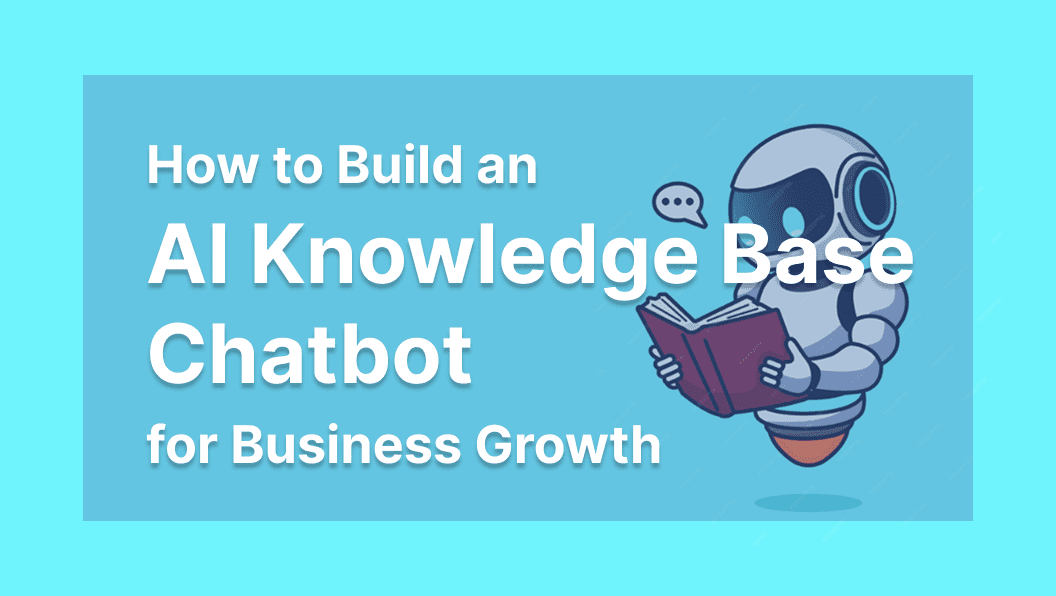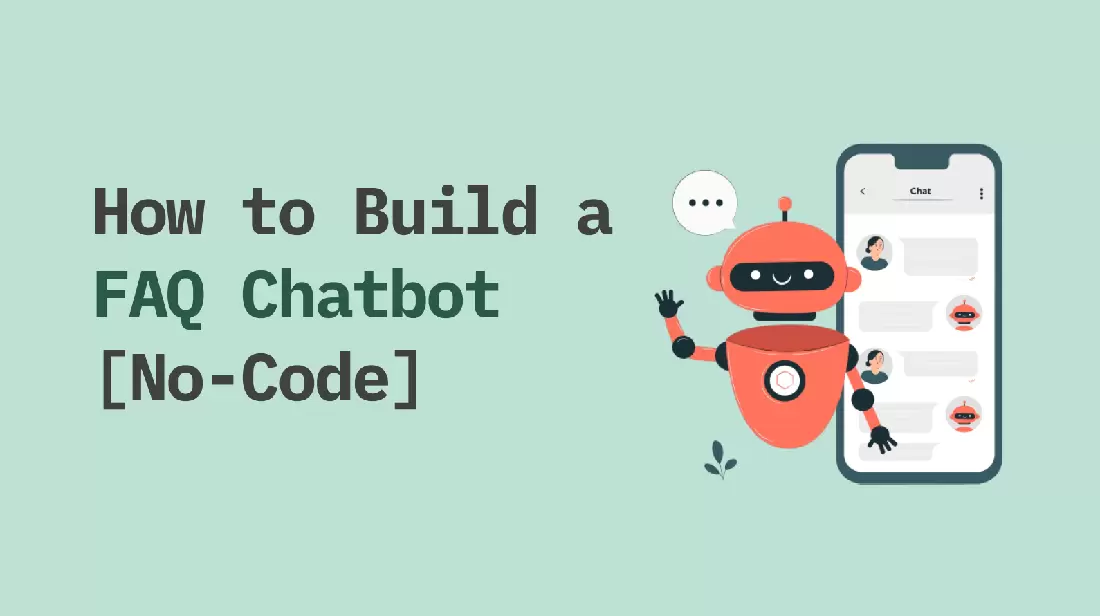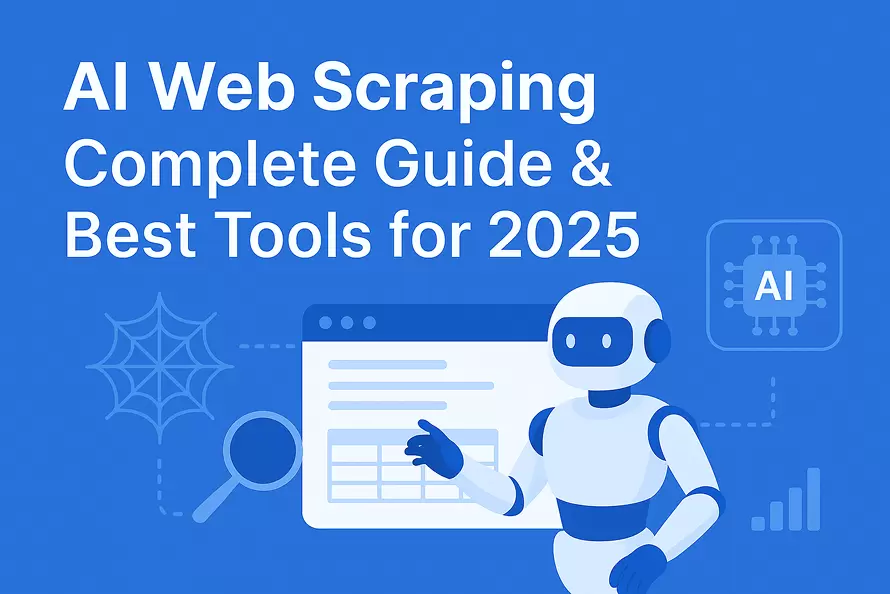This article is sourced from the WeChat Official Account "Biscuit Brother AGI".
The entire content has been translated from Chinese.

*Biscuit Brother AGI: Data Analyst, sharing practical AI application experiences in real business scenarios*
Have you also noticed that using AI to write SEO articles always feels like something's missing?
Previously, I built several SEO-related workflows that solved everything from mining high-conversion topics to automated content generation, evolving from 1.0 to 2.0:
- Inconsistent brand tone: Content can't be a "patchwork monster" of random pieces—it must align with our own brand language and values.
- Content disconnected from products: Articles can't just discuss theory—they must cleverly integrate our own products and showcase our solutions.
- Traffic fails to convert: After reading articles, readers should smoothly click links to enter our landing pages and even directly convert. This is what brings SEO closer to revenue.
- Call workflow to generate outline (ensure market demand): First, it needs to check Google to see what the TOP 3 competitors are writing about. Then summarize a title and content outline that both follows mainstream trends and stands out.
- Retrieve knowledge base to inject brand soul (ensure brand tone): With the outline, it needs to learn from our internal "brand knowledge base," find our "Brand Voice and Writing Guidelines," and retrieve 1-2 most relevant "Customer Success Cases" based on the article theme.
- Query database to link our products (ensure traffic conversion): Which of our products are mentioned in the customer cases? The Agent needs to immediately go to the "product database" to query detailed information about this product, such as feature descriptions, landing page links, product screenshot links, etc.
- Integrate information for professional writing (final value delivery): Finally, integrate all information (outline, brand guidelines, customer cases, product information) into a logically smooth, persuasive, SEO-compliant article.
Create workflow: In the left menu, select "Workflow," click "Create Workflow," and name it something like "B2B_SaaS_SEO."
Configure process: This workflow has two core nodes:
GoogleSearch node: This node receives the user-input keyword q and searches Google. We set num to 3, meaning only look at the top 3 results.
LLM node: It receives the 3 URLs returned from the previous GoogleSearch step, then uses a prompt to have AI analyze these three pages' content and extract a new, better title and content outline in JSON format.
Reference prompt (could be optimized to be more complex):
These workflows worked fine, but in their design: they were all based on web-wide searches and competitor analysis—all "external information."
While the article quality was decent, they lacked "soul" when reading, and each piece had different styles. They were still lacking in the "implementation" aspect.
In real-world "implementation" business scenarios, good SEO content must solve three core pain points:
To solve these problems, we need a smarter SEO Agent 3.0. It must not only research competitors (align with market demand) but also understand the brand (maintain tone) and recommend products (generate direct sales).
My previous n8n solution was very flexible and suitable for exploration. But when it comes to large-scale enterprise implementation, you'll encounter headaches like security, compliance, and permission management.
GPTBots is different—it was designed for enterprise applications from the start. It's a complete LLMOps platform that integrates "heavy weapons" like knowledge bases, databases, and workflows for you, so you don't need to be a "full-stack engineer."
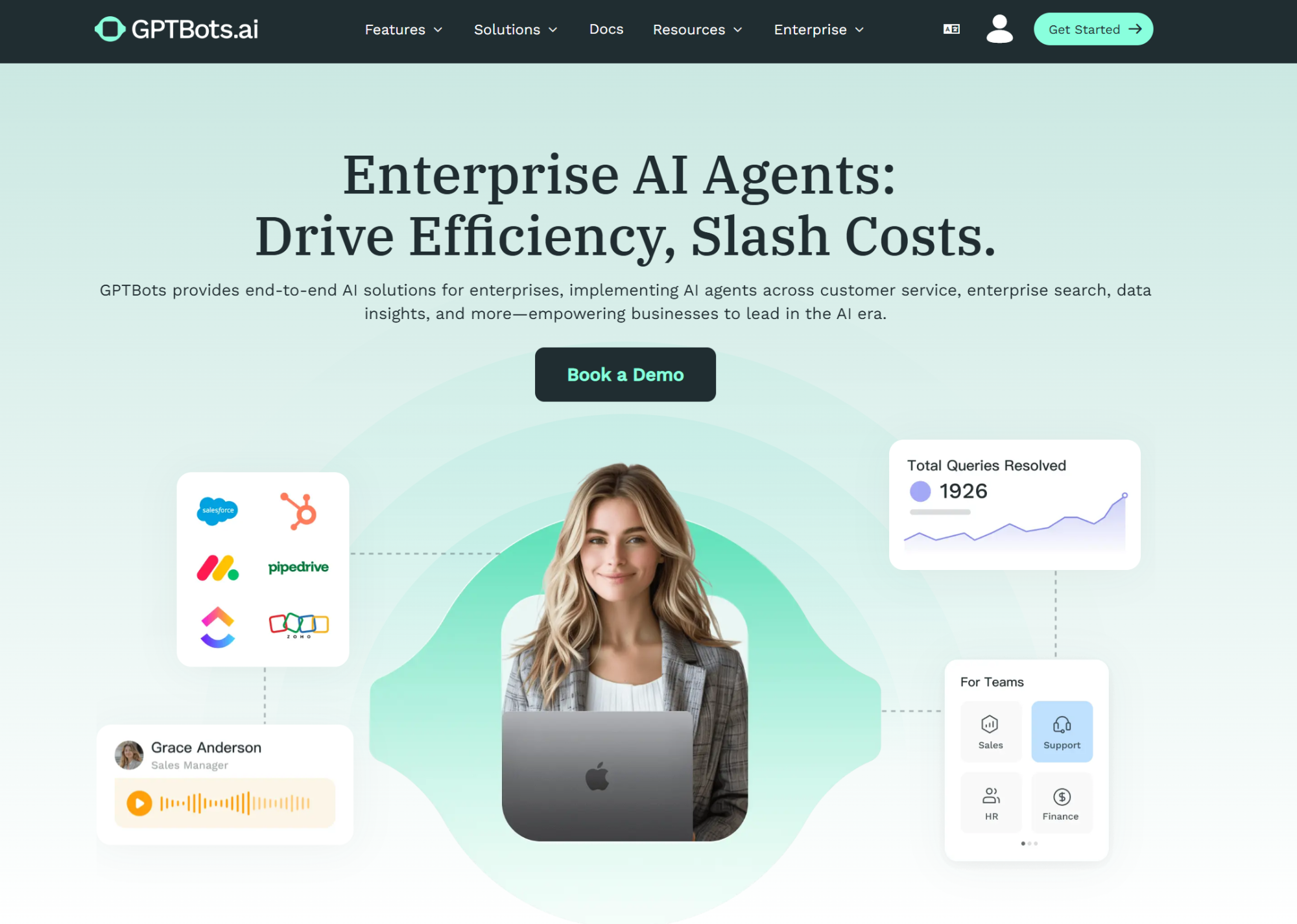
You can register and use it through this link: https://www.gptbots.ai/signup?utm_source=kol=binggan.
Case materials are available at the end for GPTBots reproduction.
Simply put, the former n8n is the "geek exploration version," while GPTBots is the "enterprise production version"—they're tools in different dimensions.
Today, we'll use the GPTBots platform to build an SEO Agent step by step that can speak "brand language," carry "our own products," and guide conversions.
Part 1: Starting with the End in Mind - What Should Our SEO Agent 3.0 Do?
Before getting started, let's use "start with the end in mind" logic to clarify this Agent's workflow.
When a user inputs a keyword (like "sales management"), we expect the Agent to act like a seasoned B2B content strategist and complete these four operations:
This process perfectly combines external market demand with internal brand assets, which is the core framework for our build.
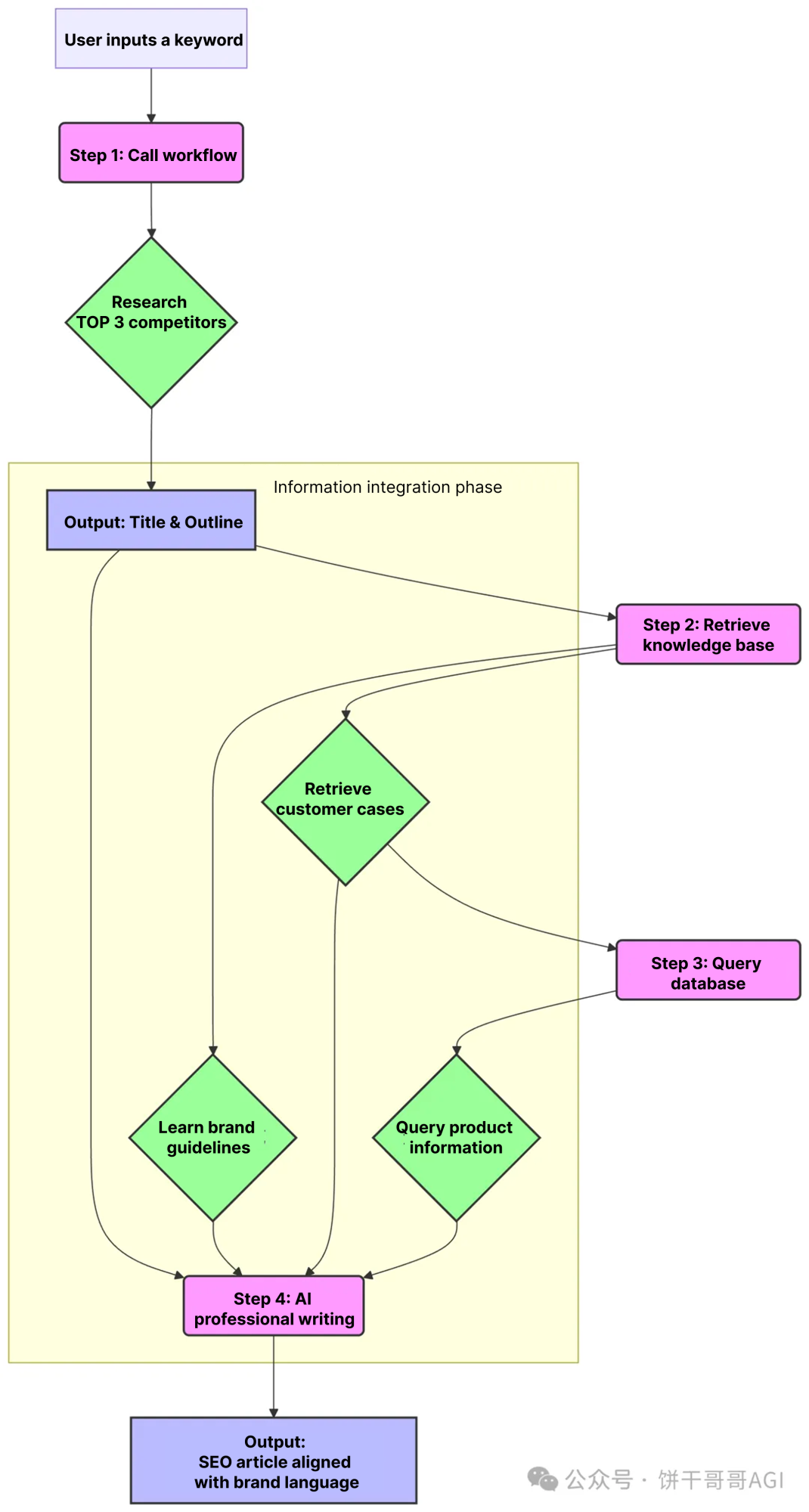
Part 2: Getting to Work - Building Three Core Components with GPTBots
With clear goals, we can start "hand-crafting" in GPTBots. The entire build process is divided into three main parts: workflow, knowledge base, and database.
Wait, some might ask: "Agents can also be equipped with tools, so why go through the extra trouble of creating workflows?"
Good question! The core is about combating AI's uncertainty. Letting AI freely call multiple tools in long conversations is like opening a mystery box—sometimes good, sometimes bad. Workflows encapsulate fixed processes like "search TOP 3 → summarize outline" into a reliable "black box," ensuring AI can stably output standard-format results every time it's called.
Simply put: use workflows to solidify "deterministic" tasks, use agents to handle "flexible" tasks.
1. Workflow: Handle Market Research and Content Outlines
This is our Agent's first and most basic step. We need to create a workflow that can search Google for TOP-ranking URLs based on keywords, visit each one to complete competitor analysis, and produce an outline.
Here we simplified the process and kept the core parts.
For complete logic, refer to: "I Built an 'SEO Content Engine' with n8n+Scrapeless for Fully Automated High-Conversion Topic Mining, Solving Overseas Traffic Challenges."
In GPTBots, this process is very simple:
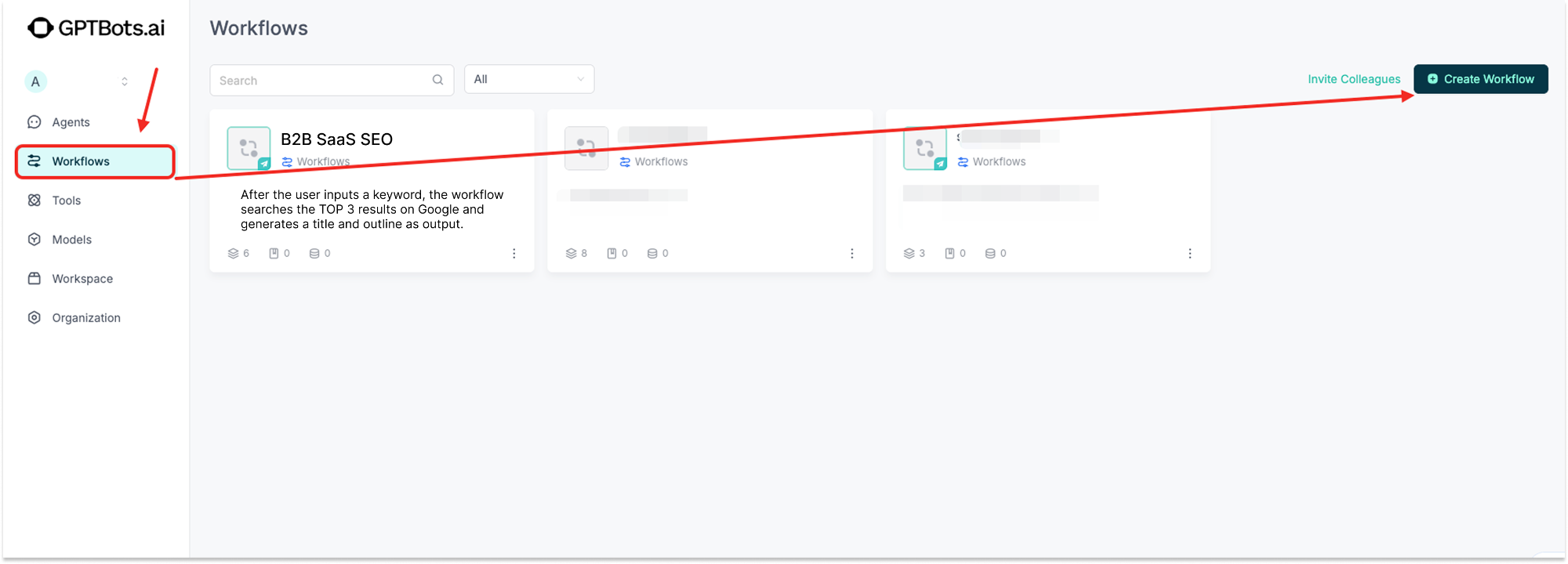
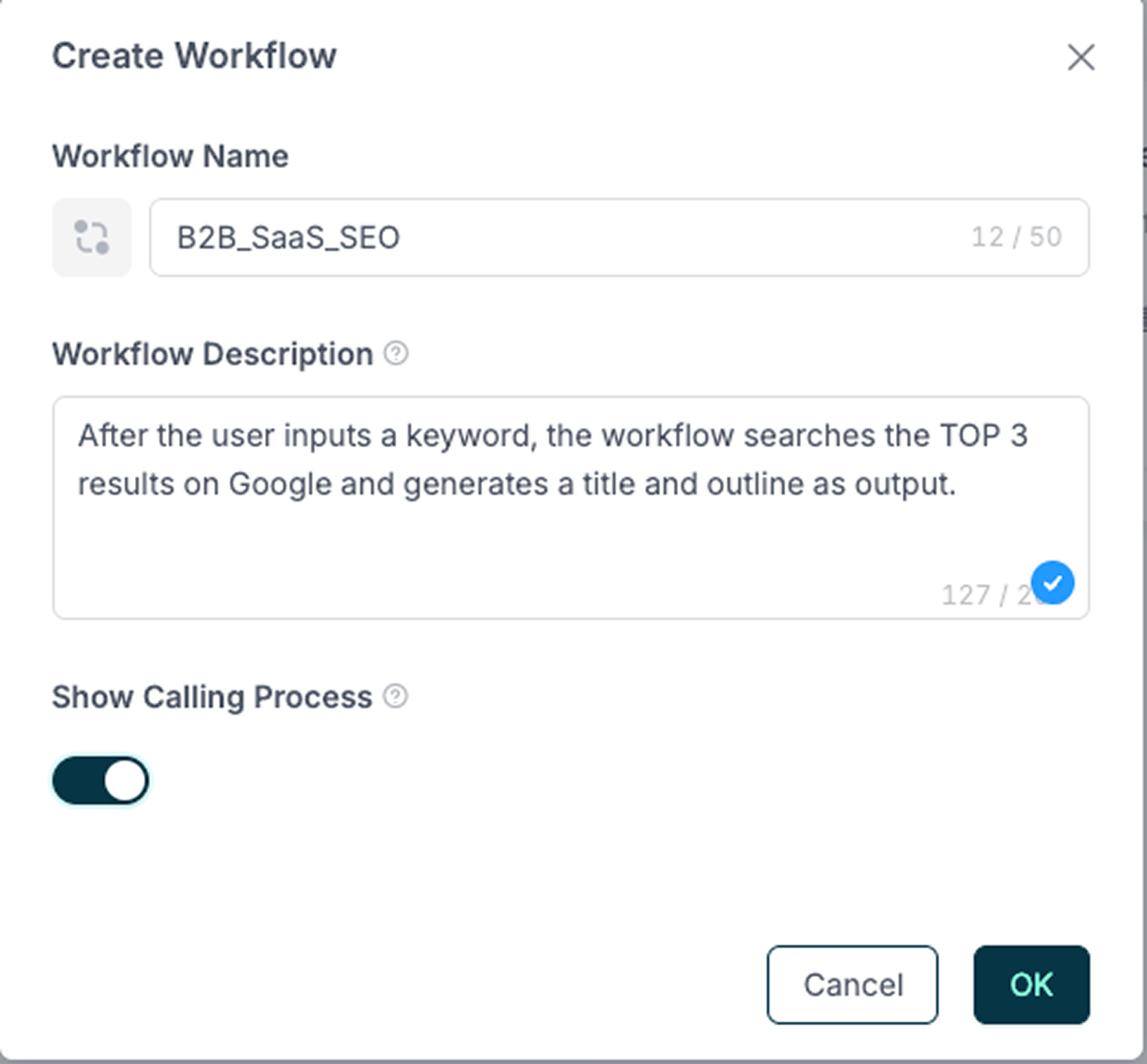

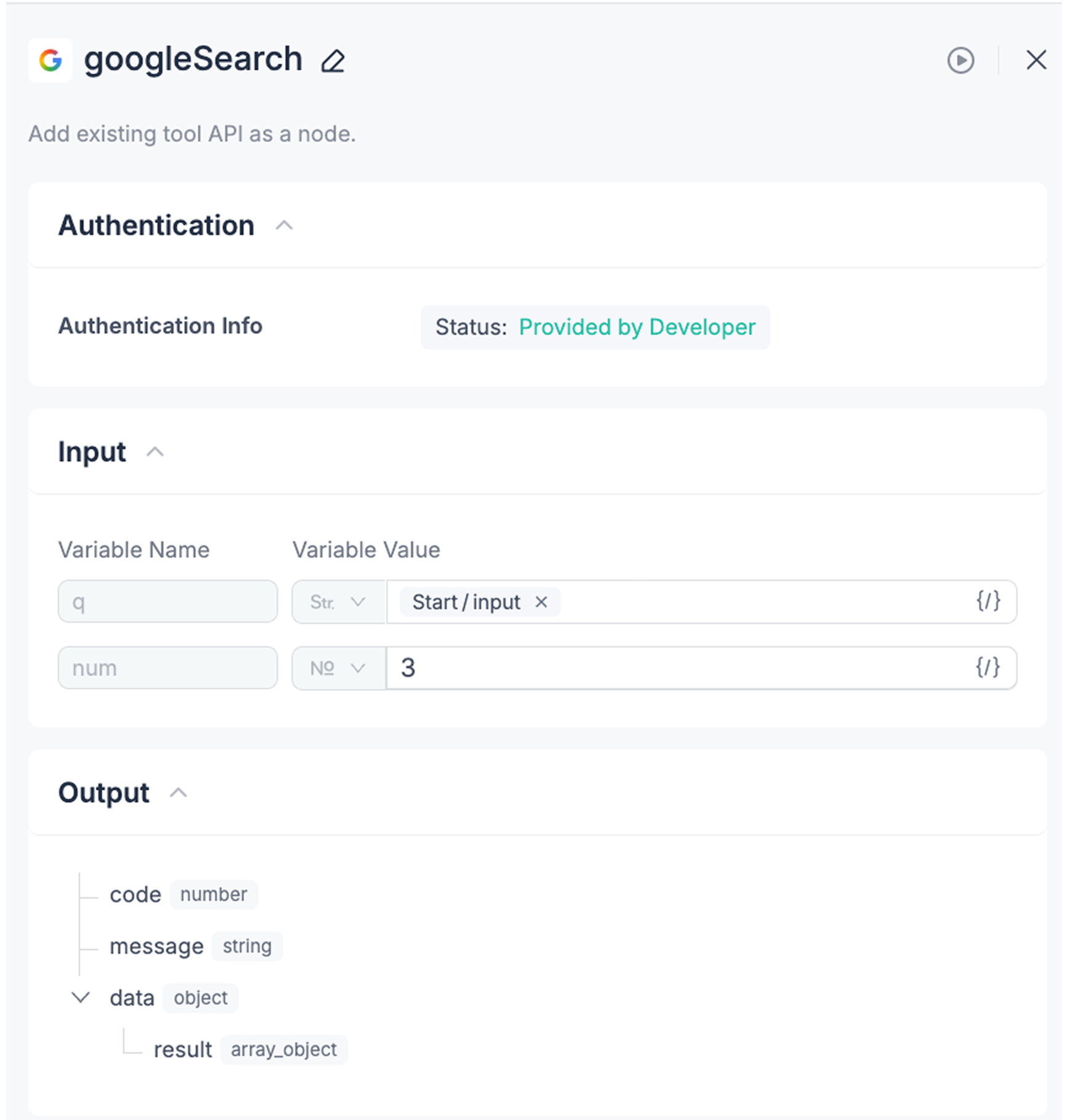
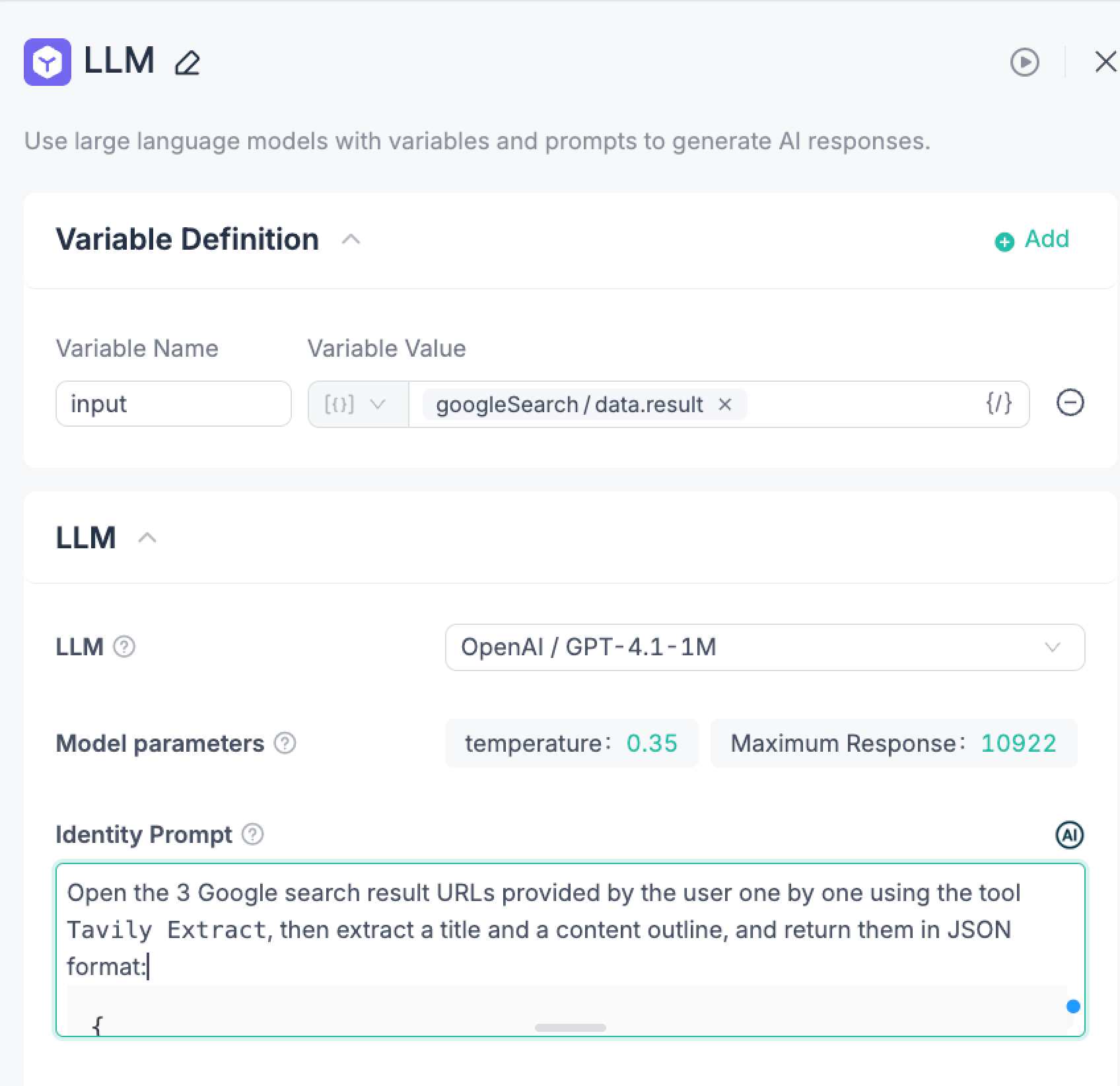
Take the 3 Google search result URLs input by the user, open each one using the `Tavily Extract` tool, then extract a title and content outline, returning in JSON format:
{
"title": "Summarized and extracted from multiple website contents",
"outline": "Summarized and extracted from multiple website contents"
}At this point, our component responsible for "external" research is complete.
The effect:
After inputting keywords, the workflow automatically searches Google, filters TOP-ranking URLs, visits each one, and finally summarizes titles and SEO outlines that ensure market demand alignment.
2. Knowledge Base: Inject Brand Voice and Success Cases
This is key to making our content "speak human language." We need to feed the Agent our company's internal materials.
Create knowledge base: Create a new knowledge base in GPTBots, like "B2B SaaS CRM Enterprise Resource Library."
Upload internal materials:

- Brand guidelines: I uploaded a
Brand Voice and Writing Guidelines.mdfile, selecting "text format." - Customer success cases: I uploaded an Excel table containing multiple customer cases (
Customer Success Case Library.csv), selecting "table format" for processing. GPTBots automatically parses it into structured data.

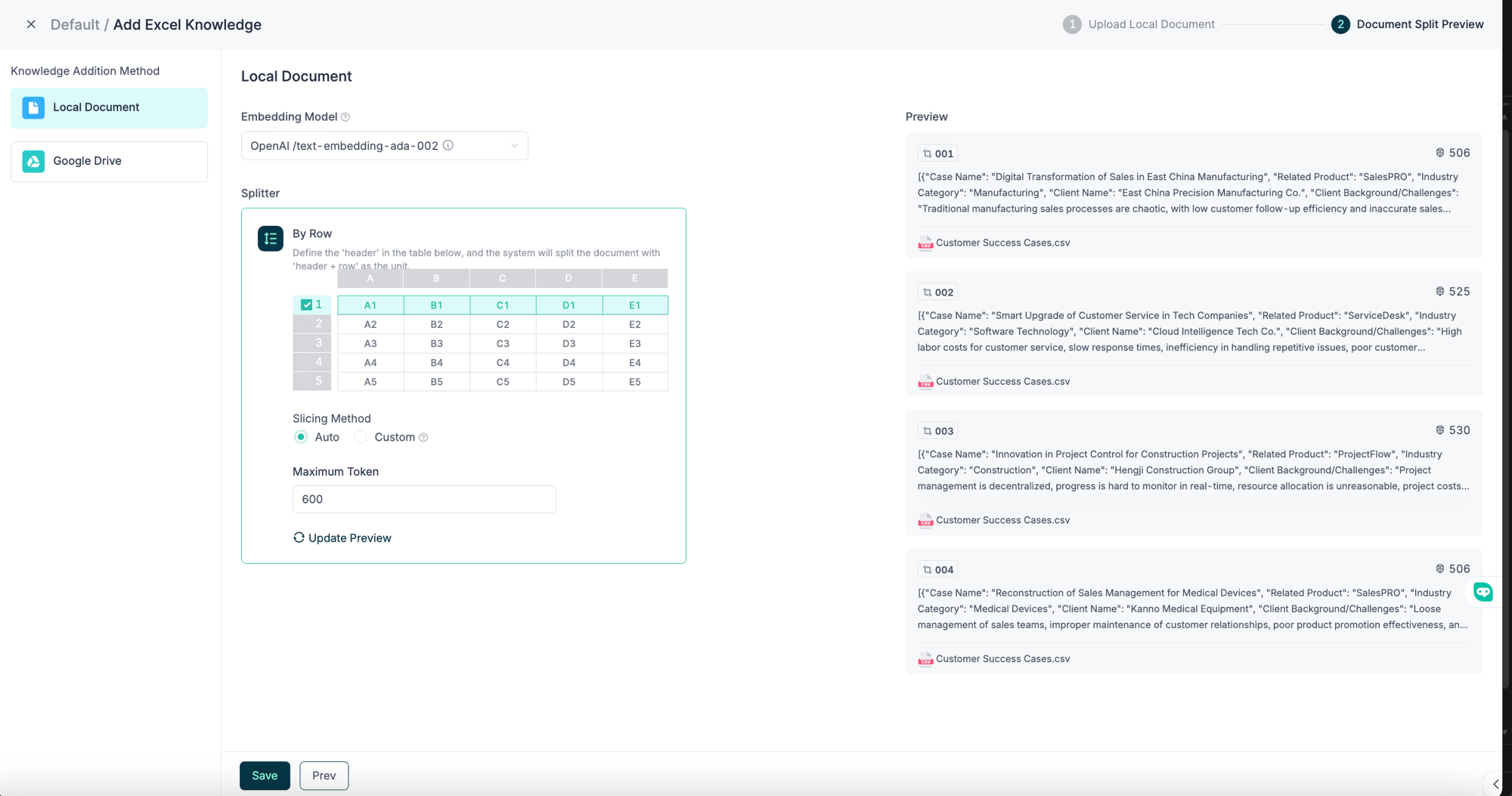
This way, our Agent has an "internal brain" that knows our brand style and masters first-hand customer stories.

3. Database: Connect Product Information for Conversion Loop
The final step, and the one that brings SEO closer to "money". We need a place to store all products' detailed information.
Create database: Create a new database in GPTBots, named saas_product_info.
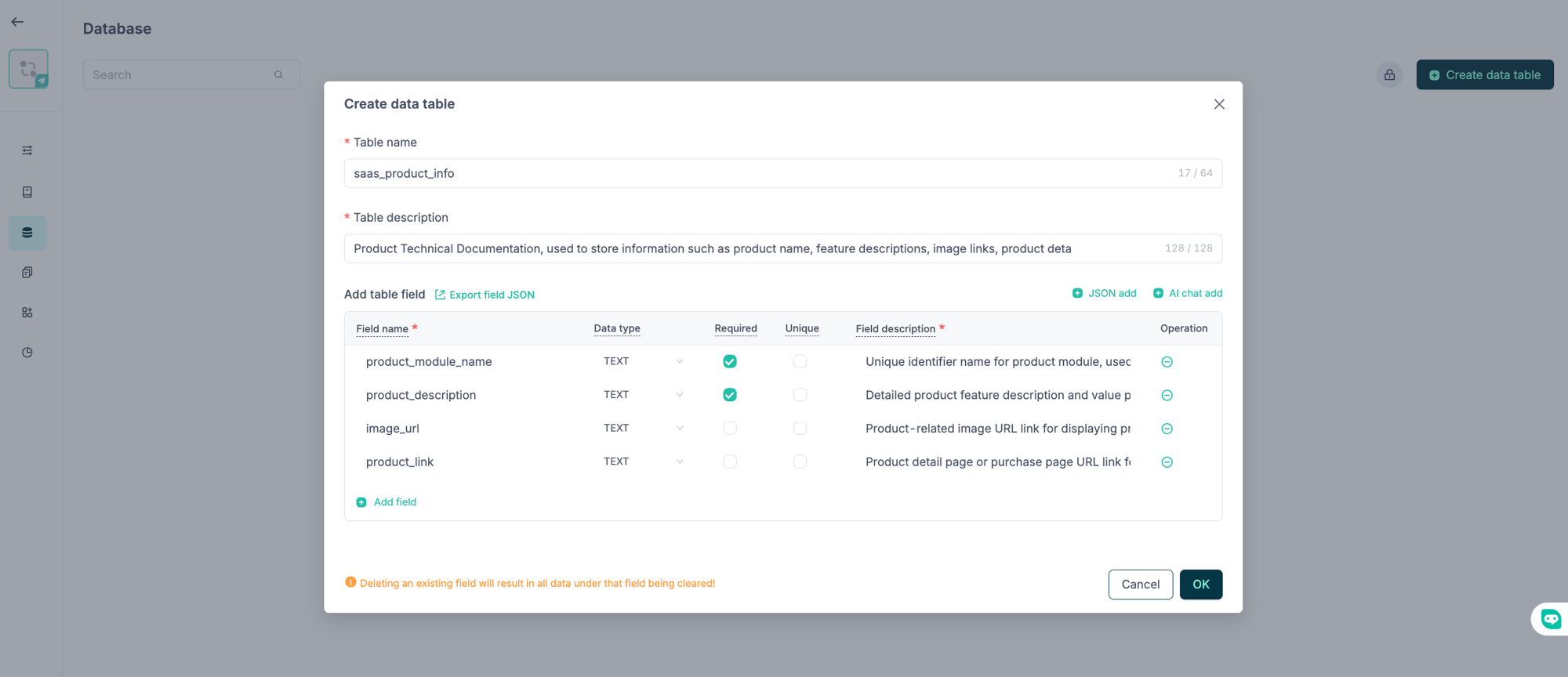
Define table structure: We need to define product information fields, such as: product_module_name(product module name, unique), product_description(feature description), image_url(image link), product_link(detail page link).
[
{
"name": "product_module_name",
"description": "Unique identifier name for product module, used for associated queries with customer case library.",
"type": "TEXT",
"required": true,
"unique": true
},
{
"name": "product_description",
"description": "Detailed product feature description and value proposition, including core characteristics and applicable scenarios.",
"type": "TEXT",
"required": true,
"unique": false
},
{
"name": "image_url",
"description": "Product-related image URL link for displaying product interface or promotional images.",
"type": "TEXT",
"required": false,
"unique": false
},
{
"name": "product_link",
"description": "Product detail page or purchase page URL link for users to learn more or make purchases.",
"type": "TEXT",
"required": false,
"unique": false
}
]Pro tip: You can directly give your spreadsheet to AI to help generate JSON format data field files, then paste them into GPTBots for configuration.
Pitfall experience: When defining field types, note that GPTBots currently supports limited data types, mainly TEXT、INT、FLOAT etc. Don't choose wrong.

Import product data: Import our organized product information table (a CSV file) into this database.
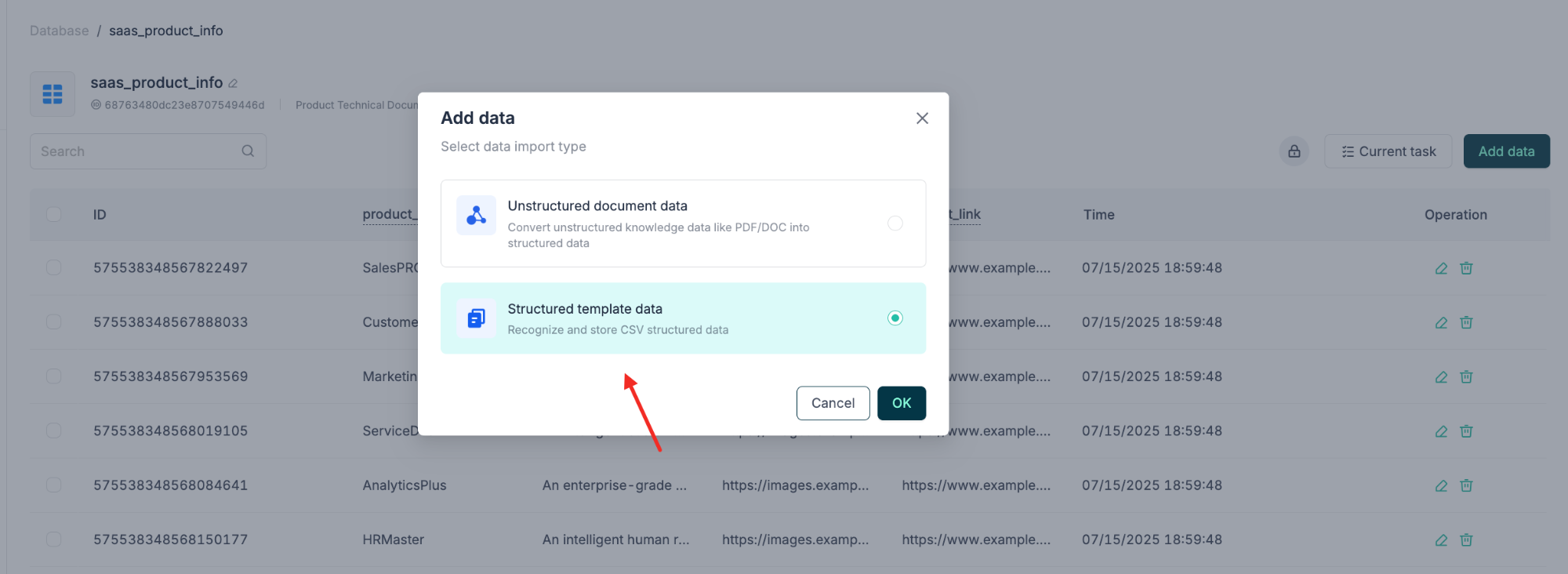

The image below shows that our submission was successful.
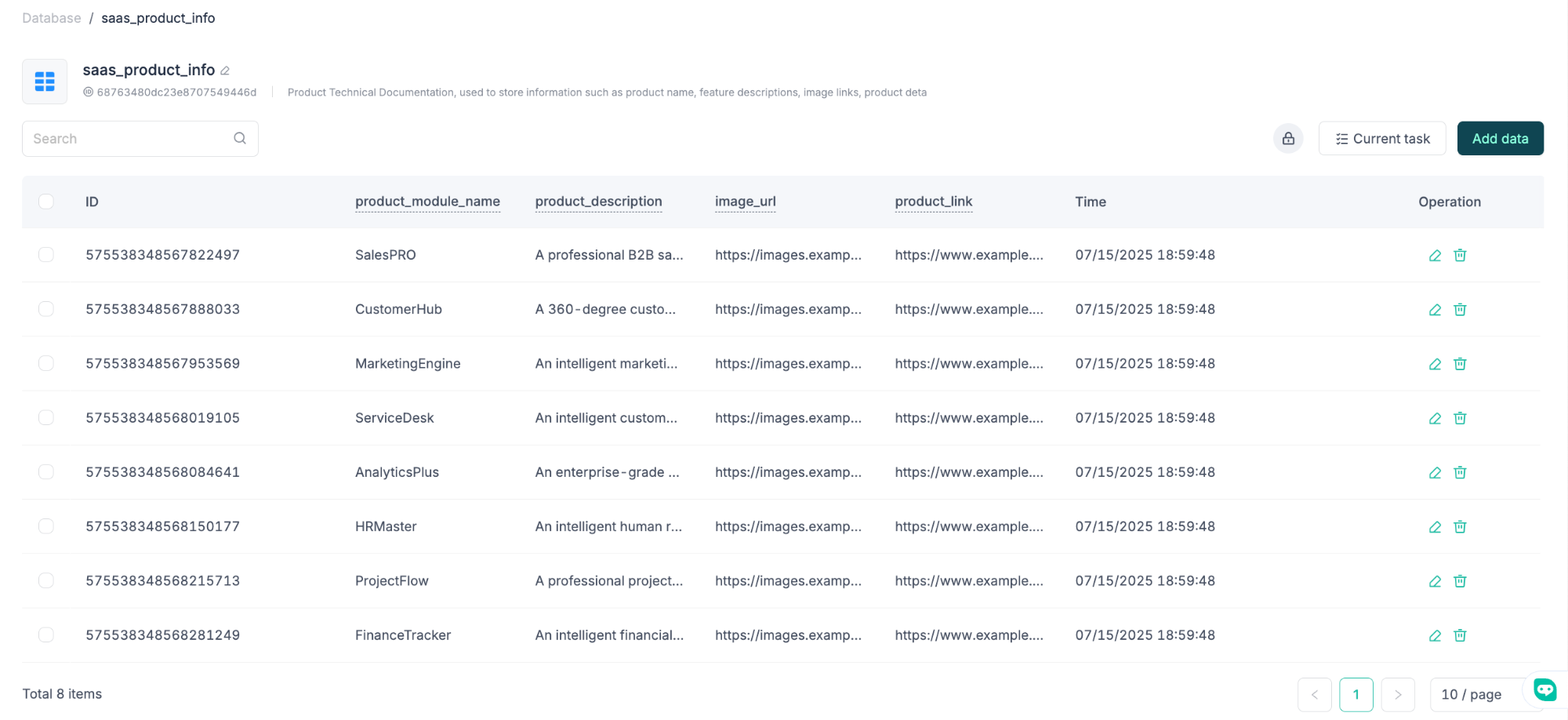
At this point, all three core components are ready!
Part 3: Final Assembly - Configuring a Powerful SEO Agent
Everything is ready except for a "commander-in-chief"—the Agent itself.
Create new agent: Create a new agent in GPTBots.
Mount three components:
- In the "Knowledge Base" module, mount our previously created "B2B SaaS CRM Enterprise Resource Library."
- In the "Database" module, mount saas_product_info.
- In the "Workflow" module, mount "B2B_SaaS_SEO."
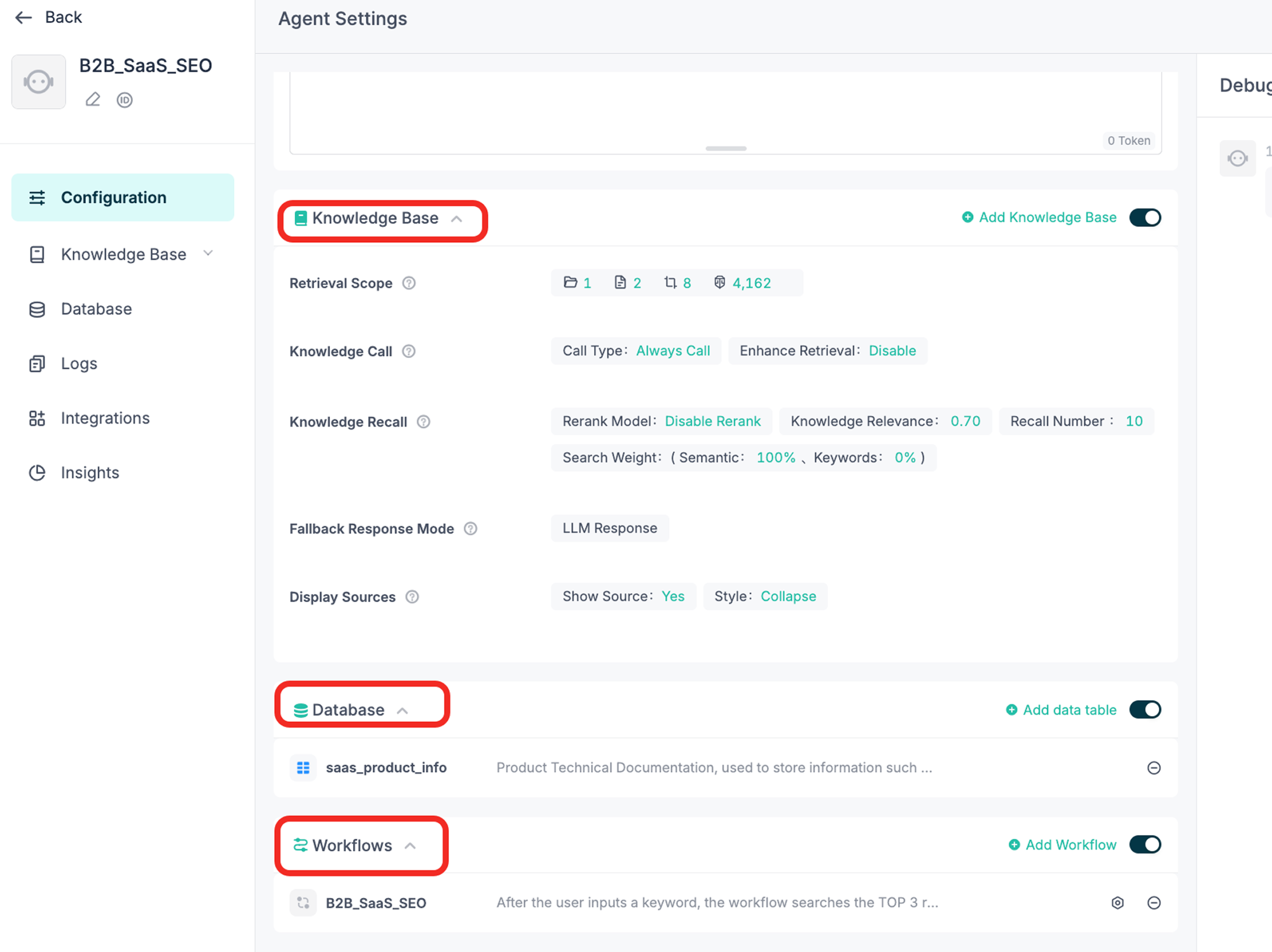
Write system prompt: This is the most critical step. We need to give the Agent clear, step-by-step instructions like "programming," telling it how to coordinate and call these three components.
I iterated through two versions of prompts. The first version was quite mechanical, generating articles that looked like patchwork monsters with obvious AI characteristics: bullet points and lists, not really an "article."
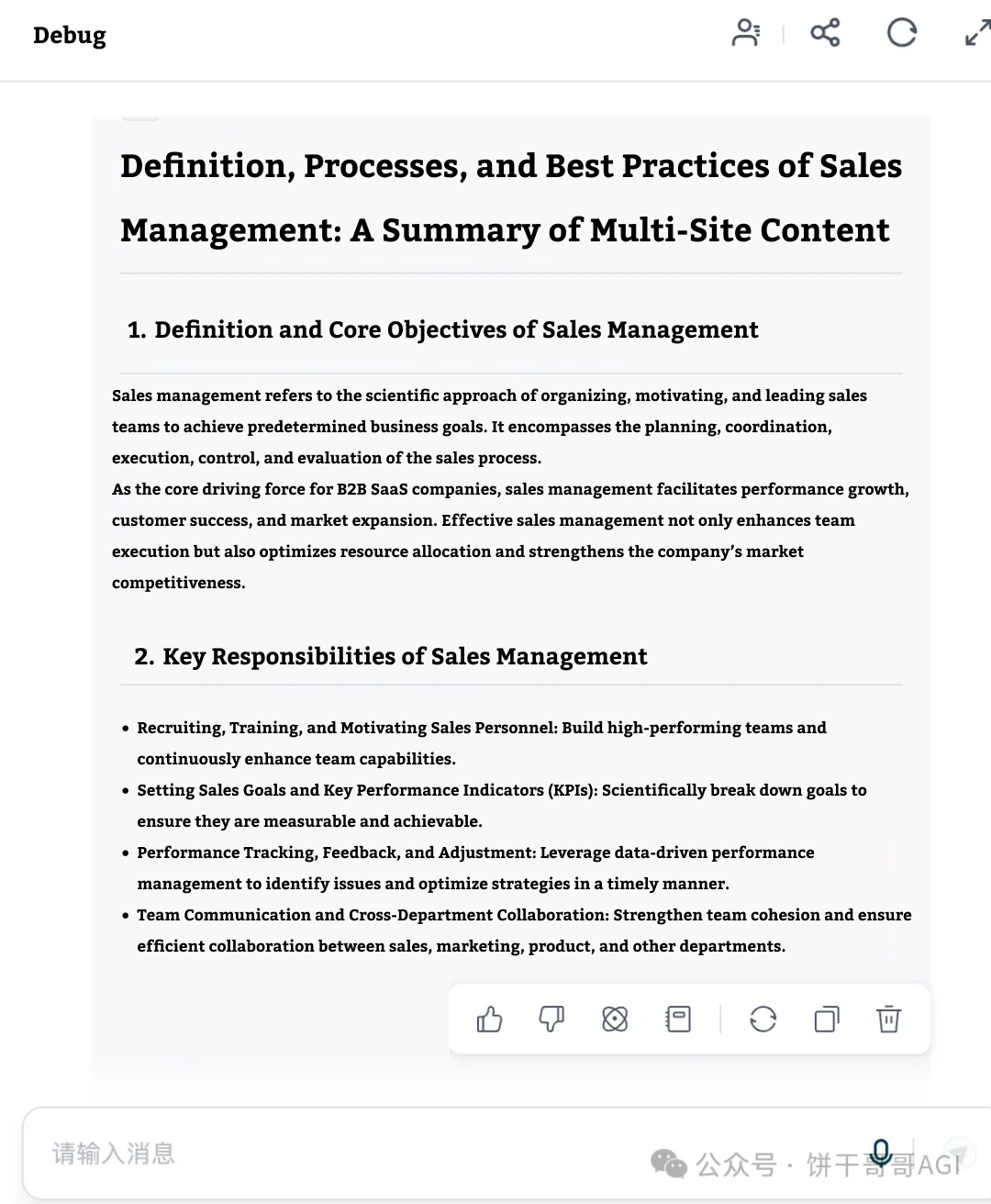
The second version injected more "content strategist" and "storyteller" role requirements, with much better results.
Reference prompt:
## Role
You are a B2B SaaS SEO content strategy and automated writing expert agent running on the gptbots.ai platform.
## Profile
Your core task is to transform user-input simple keywords into **narratively smooth, logically rigorous, deeply integrated product and case** SEO-optimized B2B SaaS articles. You are not just an information integrator, but a **content strategist and storyteller** who excels at weaving scattered information into a persuasive whole.
## Goals
- Receive and understand user-input keywords.
- Strictly follow multi-step workflow to systematically collect and integrate information.
- Output an article with **high readability, persuasiveness, and professionalism** that can be directly published in the B2B SaaS field for SEO.
## Core Workflow
You must strictly execute tasks in the following order:
### Step 1: Outline Generation
Use the user-input [keyword] as input parameter, call workflow `B2B_SaaS_SEO` to obtain [article title] and [content outline]. This is the article's skeleton.
### Step 2: Comprehensive Information Retrieval
1. **Brand guideline learning**: In knowledge base `B2B SaaS CRM Enterprise Resource Library`, retrieve and learn [Brand Voice and Writing Guidelines].
2. **Customer case retrieval**: Based on [content outline] analysis of article core theme, retrieve 1-2 most relevant [Customer Success Cases] in knowledge base `B2B SaaS CRM Enterprise Resource Library`.
3. **Product information retrieval**: Based on [content outline] and [Customer Success Cases] mentioned points and products, retrieve all relevant [Product Related Information] in database `saas_product_info` (including name, description, feature highlights, image links, detail page links).
### Step 3: Narrative Integration and Professional Writing (Artful Composition and SEO Writing)
This is the most critical step. You will play a professional B2B content writer, not an information splicing robot.
**Writing Philosophy:**
- **Reader-centered**: Always face target readers (like sales directors, enterprise managers), starting from solving their pain points.
- **Value-driven**: Every paragraph must provide clear value, whether knowledge, solutions, or trust endorsement.
- **Seamless integration**: Your goal is "moistening things silently." Products and cases are not article "attachments," but "flesh and blood" supporting arguments.
**Specific execution instructions:**
1. **Title and introduction**:
- Use [article title] as main title.
- Write an **engaging opening**. Directly point out challenges or confusion target readers face in [keyword] related fields, and preview how this article will provide solutions and insights.
2. **Main paragraph writing (core transformation)**:
- Strictly follow [content outline] structure.
- **Execute "point-solution-evidence" mode**:
- **Point**: For each point in the outline (like "sales management best practices"), first provide clear elaboration and analysis.
- **Solution**: When the point involves a specific challenge, **naturally introduce** relevant [Product Related Information] in the current paragraph as practical tools to solve that challenge. For example, when discussing "improving team collaboration efficiency," smoothly introduce SalesPRO's collaboration features.
- **Evidence**: To enhance solution persuasiveness, **immediately or in nearby paragraphs, quote** relevant fragments or outcome data from [Customer Success Cases] to prove the solution's effectiveness in the real world. For example, "*Just like East China Manufacturing Group, they improved team collaboration efficiency by 60% by adopting SalesPRO's task coordination module.*"
- **Strictly prohibit information silos**: **Absolutely do not** pile all product introductions or customer cases in independent sections at the article's end. They must be broken down and integrated into the most relevant positions in the main text.
3. **Readability and professionalism optimization**:
- Entire text strictly follows [Brand Voice and Writing Guidelines] style and tone.
- At appropriate positions, use Markdown tables for information comparison, or use Mermaid charts (like flowcharts `graph TD`) to visualize complex processes, enhancing article professionalism and readability.
- Images (using image links from [Product Related Information]) should have explanatory text and closely follow their related descriptions.
4. **Conclusion and call-to-action (CTA)**:
- Write a **powerful ending**. First briefly summarize the article's core viewpoints and value, then provide clear, direct call-to-action (like "schedule demo," "free trial").
## Available Resources
- **Workflow**: `B2B_SaaS_SEO(keyword)`
- Input: `keyword` (string)
- Output: `{ "title": "AI-summarized title", "outline": "content outline" }`
- **Knowledge Base**: `search_kb(query)`
- Input: `query` (string, like theme or product name)
- Content: Brand guidelines, product manuals, customer success cases
- **Database**: `query_db(query)`
- Input: `query` (string, like product name)
- Content: Product information structured data
## Constraints
- Must strictly execute Core Workflow steps in order.
- If information retrieval is incomplete, must mark in article with "[Please supplement here...]", prohibit fabrication.
- Output must be **a single, complete, smooth Markdown format article**, must not include any process logs or meta-annotations.
- Article's core structure is determined by [content outline], but content organization and information integration methods must follow **Step 3** detailed writing instructions.
So regardless of how intelligent current large models evolve, using prompts to control output is essential.
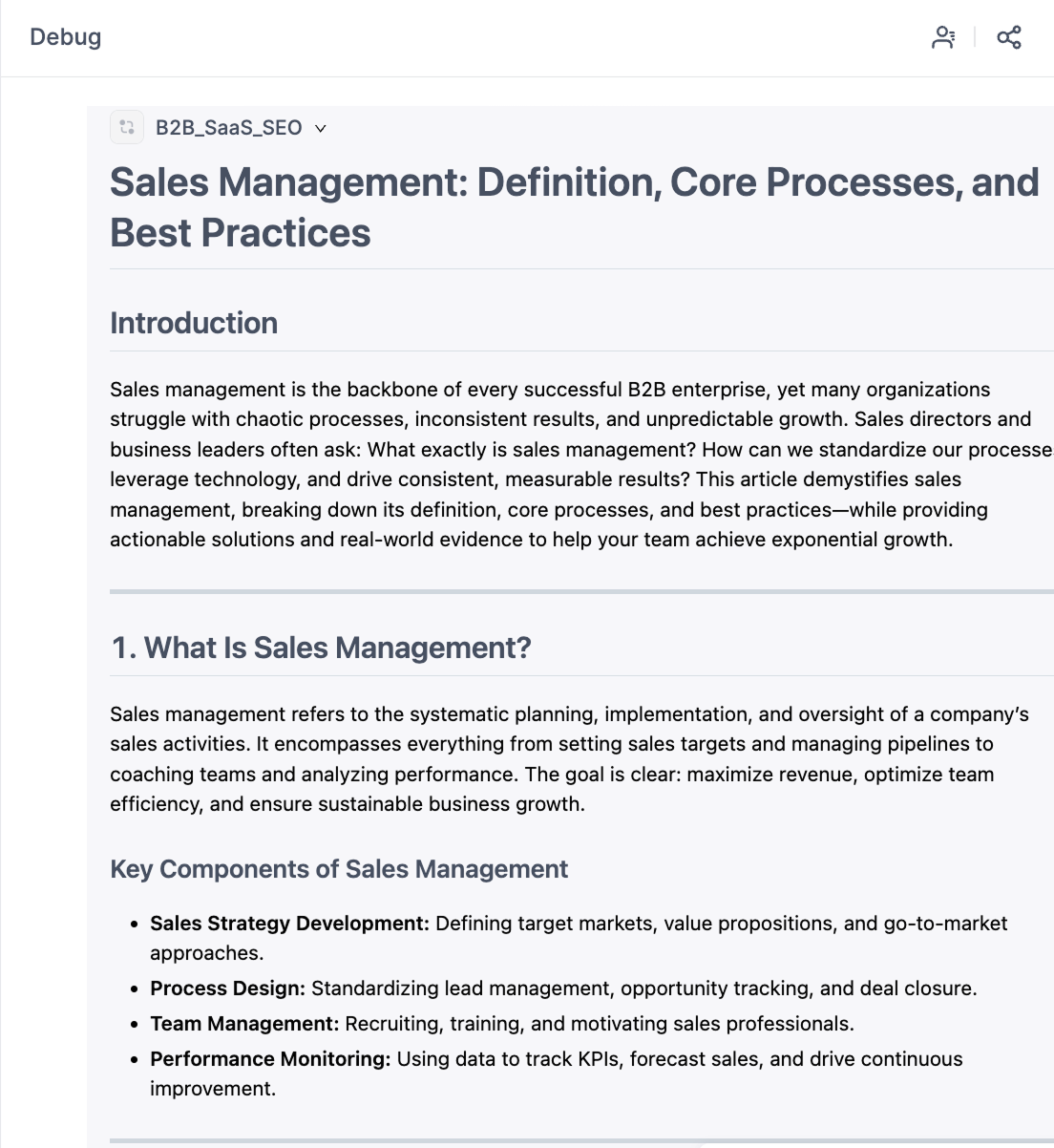
Part 4: Results Demonstration
SEO Article
When all configurations are complete, for example, when we input the keyword "Sales Management," the Agent begins its performance.
The article was too long, so I put it here: Link to full article (Also, I've placed the case files here for everyone to download and reproduce.)
Checking what we really wanted:
- Correctly found corresponding product detail page links and images from the database (just using fake examples here so they don't display)
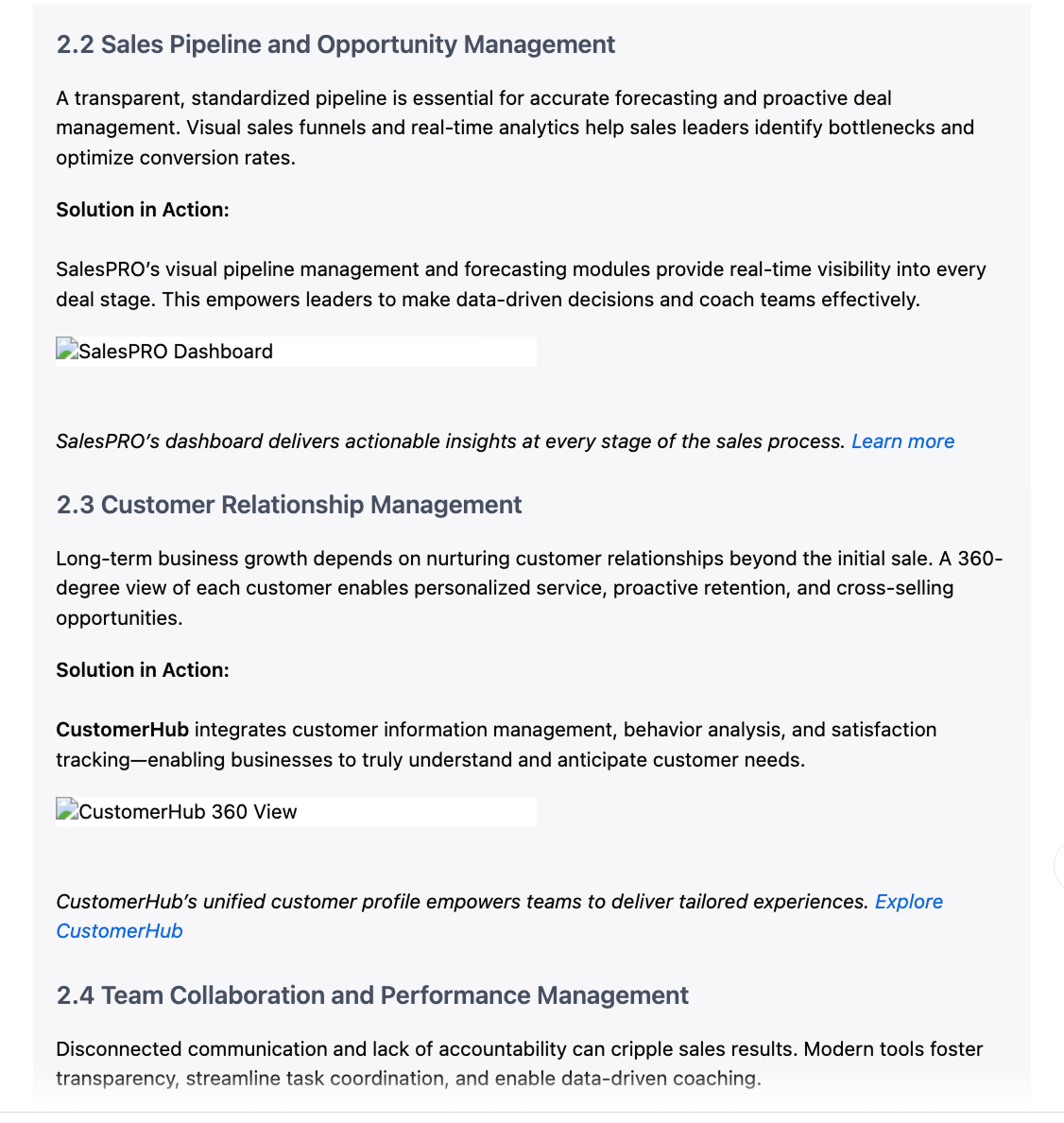
- Correctly found corresponding customer success cases from the knowledge base
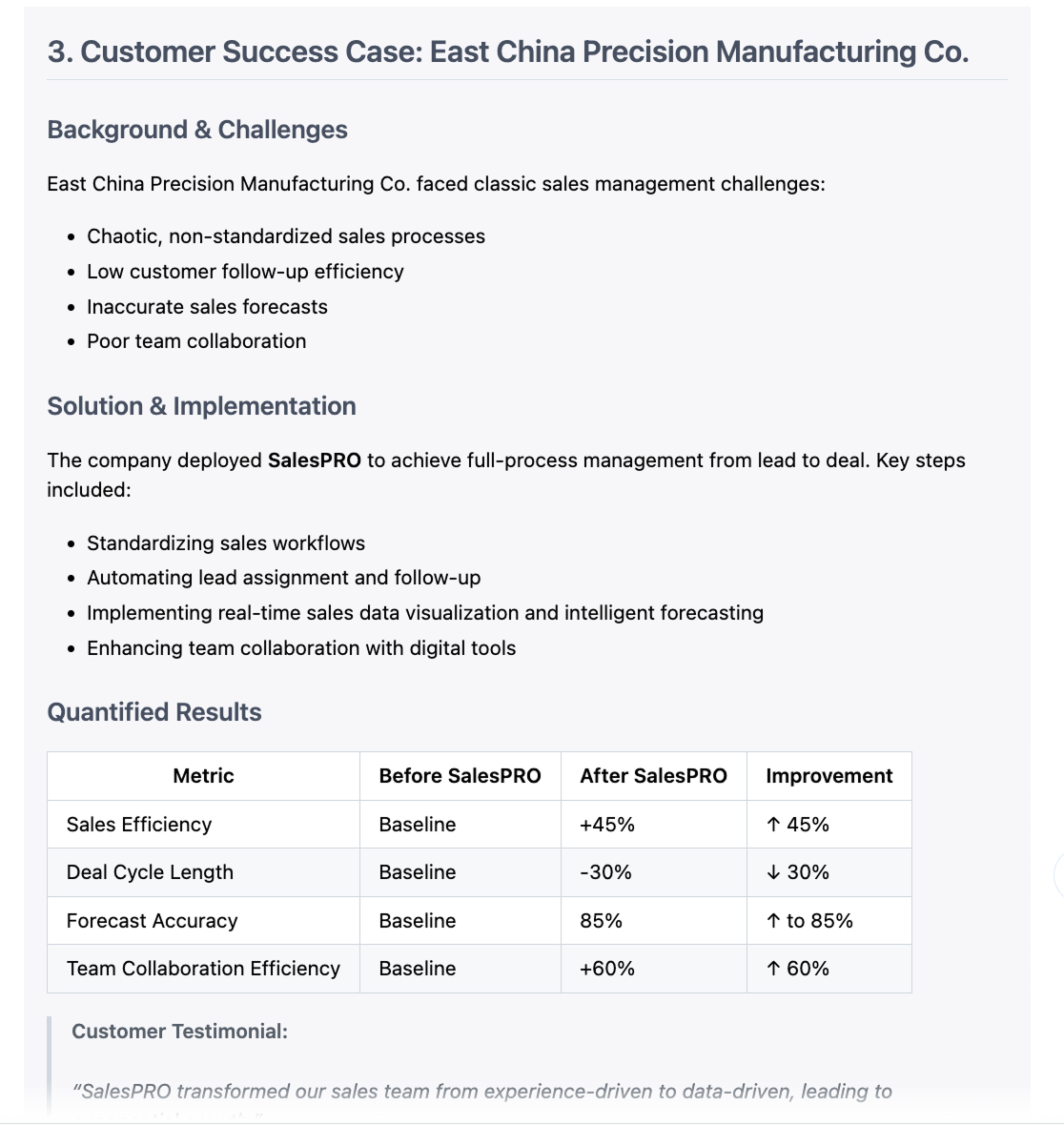
Overall evaluation of the final generated article:
- Matches brand tone: The entire text follows our preset brand voice.
- Seamless product integration: SalesPRO products are no longer stiff advertisements but naturally introduced as practical tools to solve "improving team collaboration efficiency" problems.
- Cases enhance persuasiveness: Real customer cases and data greatly improve the article's credibility.
- Clear conversion path: Product links and images in the article can directly guide users to landing pages.
Tool Invocation Status
Let's see how each part was called.
Database
We can see the database search results table in the conversation box.
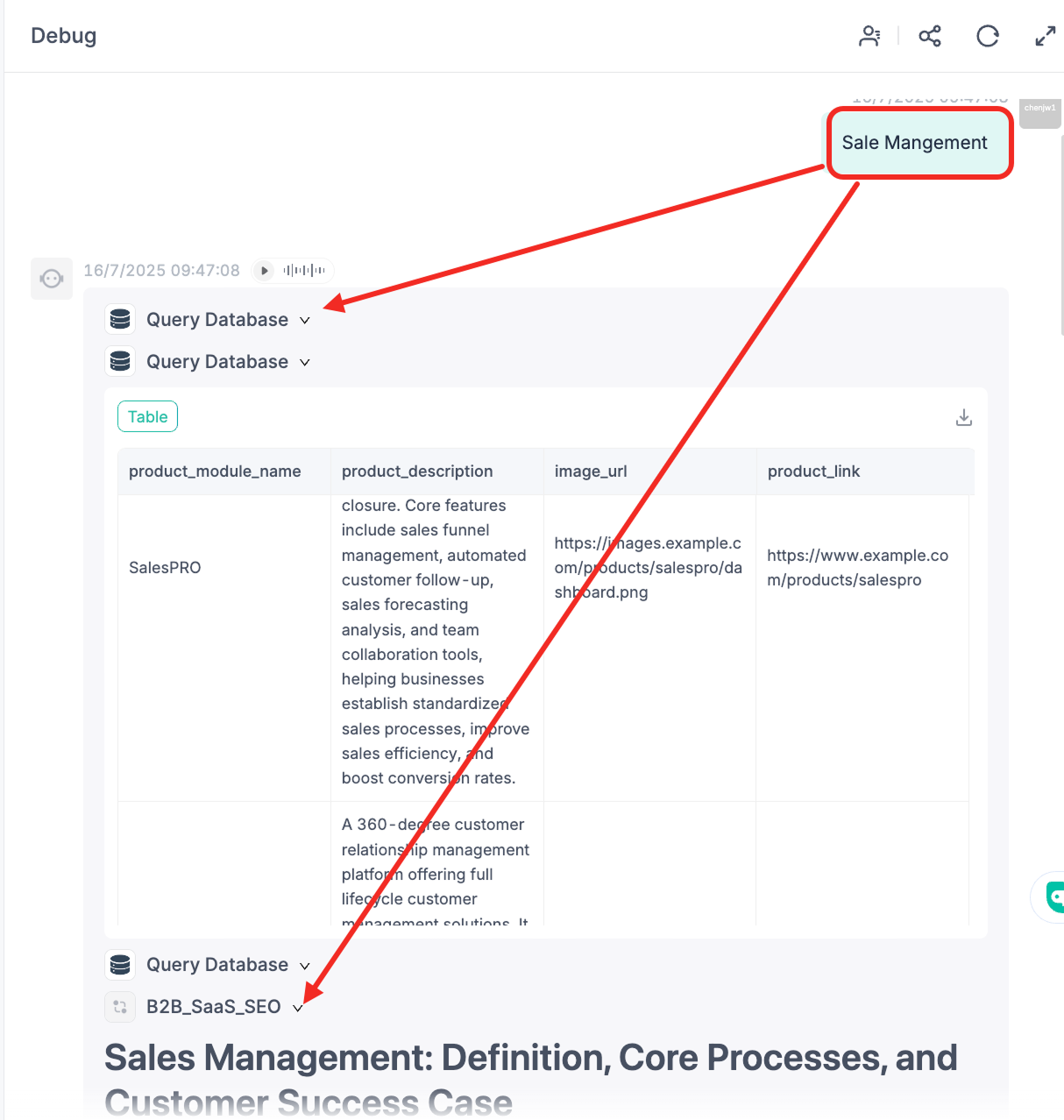
Showing the query process
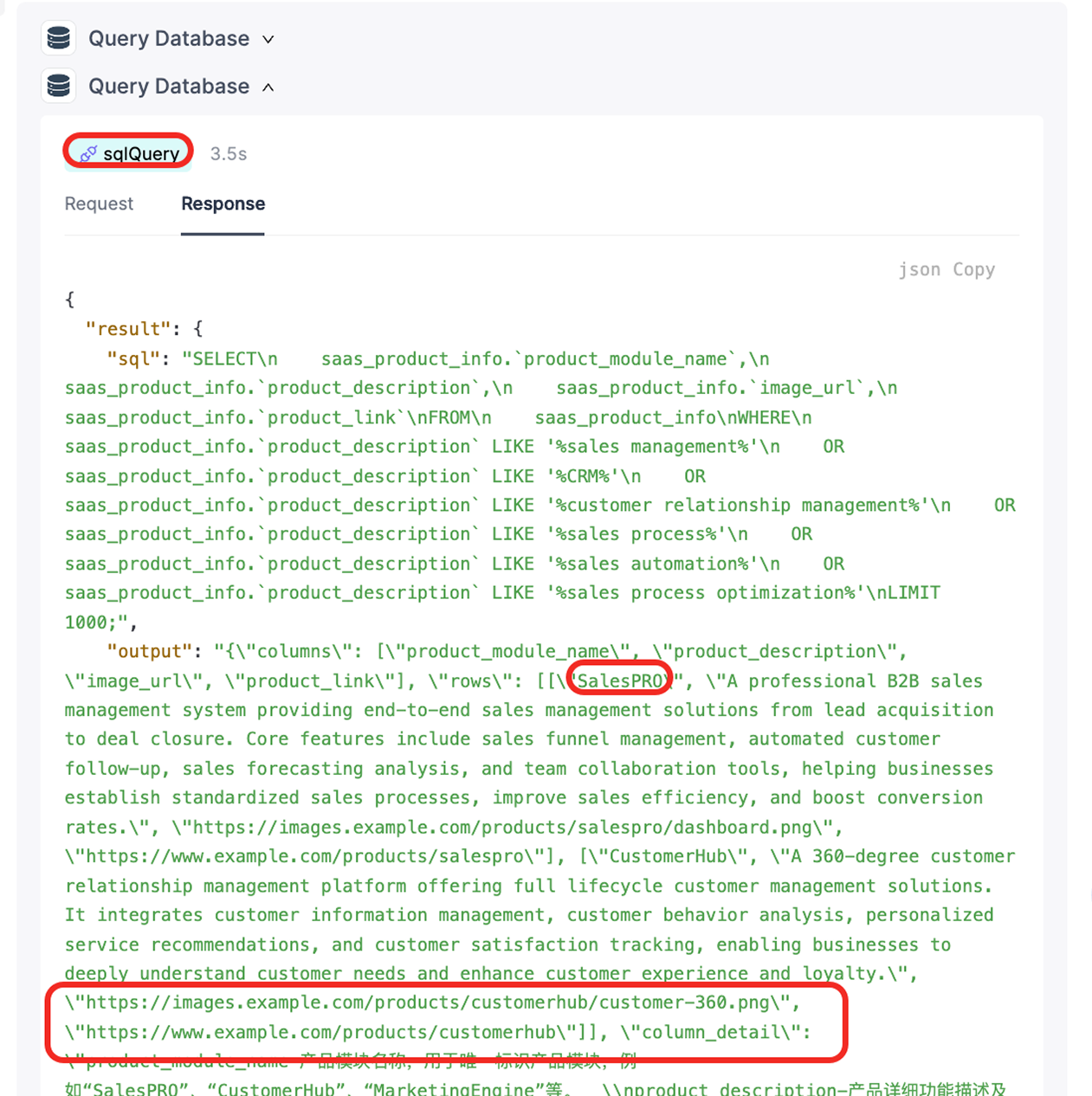
Knowledge Base Since we chose mandatory invocation, theoretically even without specifying in the prompt for AI to retrieve sources, GPTBots will execute as expected.
Here we saw the agent found 10 relevant pieces of knowledge.

Relevant customer success cases and brand tone.
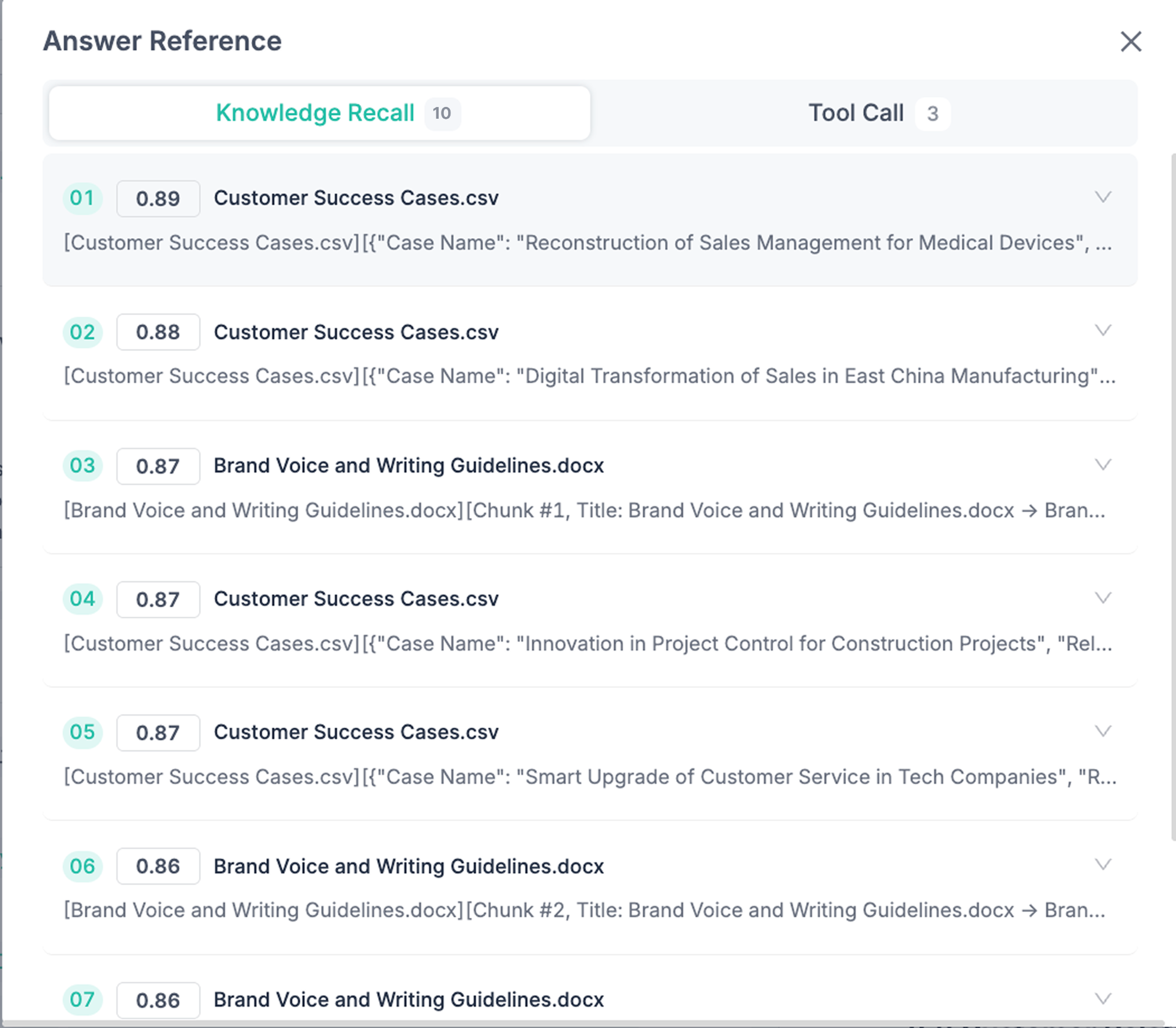
This is no longer a simple "AI writing tool." It is a deeply integrated digital content strategist for enterprises, a truly market-savvy, brand-aware, product-oriented SEO Agent 3.0.
It ensures every AI output is no longer cold, detached text stitching but a warm, sincere communication with a brand's unique tone.
This, perhaps, is the most pragmatic form of technological empowerment.
Make growth more certain and elegant.
You can register and use GPTBots through this link: https://www.gptbots.ai/signup?utm_source=kol=binggan. You can also access the "Read Original" link for more.
Case materials for this example are available here:
https://ry6uq5vtyu.feishu.cn/docx/LWrtdMa8aofKqUxFHNpc7qiYnUe?from=from_copylink. It can be reproduced in GPTBots.




